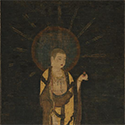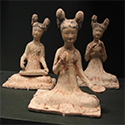|
|
| Show All 45 Results (Text Only) |
|
| Buddhist Art from China and Japan |
|
| The Cleveland Museum of Art
|
This lesson explores new objectives for art and examines how Chinese painting reflects Buddhist principles. Students learn to consider the meaning and significance of Buddhist mudras through the examination of images from the Cleveland Museum of Art.
Go to Museum Resource: http://www.clevelandart.org/lesson-plan-packet/buddhist-art-china-and-japan | |
|
|
| Buddhist Cave Temple Sculpture |
|
| Victoria and Albert Museum
|
The Central Asian tradition of building such complexes was been practiced for centuries, primarily with Imperial sponsorship in the Northern regions, where Buddhism first took hold. The very act of creating these vast monuments, hollowed out from rock faces and decorated so lavishly within, was considered an act of 'piety' resulting in the accrual of merit, which in Buddhism is accumulated as a result of good deeds, acts or thoughts. This merit is then carried over to later in life or to a person's next birth. The sculptures and paintings also functioned as an important focus for worship and as symbolic links between the worldly and heavenly realms. People would have travelled great distances to see them and to worship and make offerings before them.
Go to Museum Resource: http://www.vam.ac.uk/content/articles/c/chinese-buddhist-cave-temple-sculpture/ | |
|
|
| Buddhist Sculpture from China |
|
| China Institute
|
“The period covered by Buddhist Sculpture from China fits within Era 4 of the National History Standards, “Expanding Zones of Exchange and Encounter, 300-1000 CE”: Buddhist, Christian, and Hindu Traditions: Not only Islam but other major religions also spread widely during this 700-year era. Wherever these faiths were introduced, they carried with them a variety of cultural traditions, aesthetic ideas, and ways of organizing human endeavor. Each of them also embraced peoples of all classes and diverse languages in common worship and moral commitment….The entry of Buddhism into China and East Asia at the beginning of the Common Era is central to any perception of cultural exchange as playing “a crucial role in human history, being perhaps the most important external stimuli to change, leaving aside military conquest” (Curtin 1984: 1).”
Go to Museum Resource: https://china360online.org/?property=buddhist-sculpture-from-china | |
|
|
| Cave as Canvas: Hidden Images of Worship Along the Ancient Silk Routes |
|
| National Museum of Asian Art, Smithsonian Institution
|
Buddhist Cave Temples in Chinese Central Asia. Buddhism reached Chinese Central Asia (modern Xinjiang) from India around the first century A.D., brought by missionaries via the ancient Silk Routes. By the third century A.D., this new religion was flourishing in all the oasis kingdoms in the Tarim Basin (the Taklamakan Desert), also known as eastern Turkestan. As the Buddhist religion took hold and piety increased, the Indian tradition of excavating caves to serve as Buddhist sanctuaries proliferated in this region. In many of the Central Asian states, monasteries and temples were hewn out of the cliffs in secluded river valleys. With the patronage of local rulers, the elite, and wealthy merchants, these institutions gradually became major Buddhist centers. They continued to grow and prosper until the advent of Islam. Today, such Buddhist rock-cut cave complexes are some of the finest, if little known, monuments preserved in Chinese Central Asia.
Go to Museum Resource: https://archive.asia.si.edu/exhibitions/online/cave/default.htm | |
|
|
| China: Dawn of a Golden Age, 200–750 AD |
|
| The Metropolitan Museum of Art
|
Publication of the exhibit that explores exceptional works of art from forty-six institutions in the People's Republic of China. Includes references to works of art in the Metropolitan's permanent collection, relevant literary references, maps, and details about how certain objects were crafted. See also exhibition publication.
Go to Museum Resource: https://www.metmuseum.org/exhibitions/listings/2004/china-dawn-of-a-golden-age | |
|
|
|
|
| Chinese Handscrolls |
|
| The Metropolitan Museum of Art
|
An overview of the Chinese handscroll format: "A significant difference between Eastern and Western painting lies in the format. Unlike Western paintings, which are hung on walls and continuously visible to the eye, most Chinese paintings are not meant to be on constant view but are brought out to be seen only from time to time. This occasional viewing has everything to do with format." With images of 18 paintings from the Tang, Song, Yuan, Ming, and Qing dynasties.
Go to Museum Resource: http://www.metmuseum.org/toah/hd/chhs/hd_chhs.htm | |
|
|
|
| Show All 45 Results (Text Only) |









